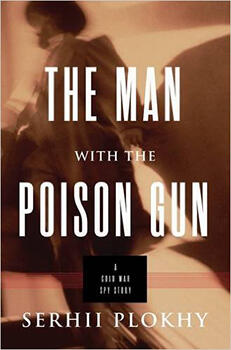 The Man with the Poison Gun: A Cold War Spy Story, Serhii Plokhy’s latest publication, tells the captivating story of Bohdan Stashinsky
The Man with the Poison Gun: A Cold War Spy Story, Serhii Plokhy’s latest publication, tells the captivating story of Bohdan Stashinsky
, a KGB assassin who eventually defected to the West. The product of meticulous archival research, the book sheds new light on this thrilling real-life drama.
While there are good reasons to associate a KGB assassin with a cold-blooded killer, Stashinsky’s path to that role was far more complicated and tragic. Forced to cooperate in order to save his family from arrest, he agreed to be a KGB informant and was subsequently groomed to serve as an assassin.
Stashinsky was tasked with killing two important members of the anti-Soviet Ukrainian nationalist organizations. The first was Lev Rebet, an intellectual, anti-communist Ukrainian émigré living in Munich. The second was none other than Stepan Bandera, whose legacy remains influential and contested in Ukraine today. Bandera, who was also living in Munich, is remembered as a heroic figure for his fight to liberate Ukraine from Soviet repression, but is considered by others to be a proponent of genocidal nationalism. At the time, he was one of the most influential, well-known leaders of the Ukrainian nationalist organizations that were fighting the Soviet regime from abroad.
Stashinsky killed both targets using a poison gun, one of the innovative weapons the KGB developed to improve the art of political killings. This gun sprayed cyanide, which, when delivered to the face of the victim, caused rapid death. Importantly for the KGB, it left no trace: The cyanide left no visible markers, and the death took on the appearance of a heart attack.
However, Stashinsky regretted what he had done on the orders from the KGB and his subsequent actions had lasting implications for the Soviet intelligence and political community.
After Stashinsky defected, he was put on trial for murder, and the case led to significant changes in Soviet leadership and the way the KGB carried out its interests abroad. This impact and the mysteries surrounding Stashinsky have been matters of intrigue ever since. By bringing to light new details, Plokhy’s book puts to rest some of the conspiracy theories surrounding the assassin’s fate.
We sat down with Serhii Plokhy to ask him a few questions about the book, his research process, and the interesting surprises he uncovered.
Bohdan Stashinsky as a student in Lviv
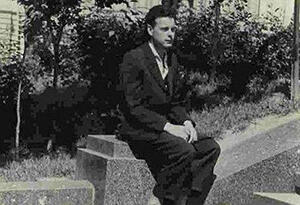 HURI: Why did you choose to write about Stashinsky now? Why is his story an important topic?
HURI: Why did you choose to write about Stashinsky now? Why is his story an important topic?
SP: I knew about Stashinsky story for quite a while, probably since the early 1990s, but in the last few years I learned that the CIA declassified a number of files dealing mostly with the Ukrainian émigré organizations in North America and Europe. I came across a reference to a CIA file in the larger file of Stepan Bandera that dealt specifically with his assassination. I thought, "Okay, maybe I can find more there." When I was in DC, I stopped by the archives and, indeed, found a CIA report from 1976.
The most interesting and puzzling part about that report was that it was written in 1976 with the purpose of evaluating whether Stashinsky really was who he said he was, whether or not he was actually acting on behalf of the KGB.
That was very interesting because one of the main theories in the media and among historians was that it was the CIA that arranged for him to have a shorter sentence than he otherwise would have received for killing two people, that they were hiding him, that they helped him to do a plastic operation, that he was living somewhere in the United States.
But then you come across something from 1976 where the CIA is still debating whether he was the person he said he was. This, of course, makes the whole story much more interesting, and many questions that people believed were closed were now posed anew.
HURI: Did you also have access to KGB files?
SP: Yes. I had access to the KGB files, and I found the most interesting ones last summer. The book was already in the works - I already had the proofs - and at that time I found the new materials. It was too late to put all of them into the book. So I tried to put the most important facts wherever I could without shifting the pages.
The most important file was the personal file of the KGB officer who was Stashinsky’s handler. Maybe the details that couldn’t go into the book will appear in the Ukrainian translation, which is being prepared now in Kyiv.
HURI: That was actually one of the other questions I had: Was there anything that you thought was really interesting that didn't make it into the book?
SP: Yes, indeed. So, those would be the details coming mostly from the files I found in Kyiv.
What didn't make it into the book was, for example, the way the KGB was still trying to play the so-called "Bandera card," even after the assassinations took place. They produced a fake letter from Bandera, which allegedly was discovered and, Bandera being dead at this point, he couldn’t confirm whether this was his letter or not. So allegedly his letter contained all sorts of attacks on people around him and in the branches of the organizations that were in competition with his organization.
The KGB’s goal was actually to use Bandera, even after his death, to create confusion and internal fighting within the Ukrainian émigré community.
Stepan Bandera
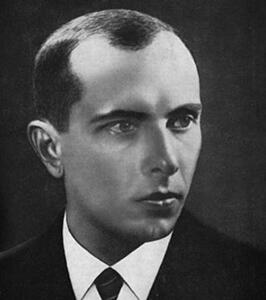 HURI: Could you talk a little about the Ukrainian anti-Soviet movement and the community that Bandera was a part of at that point?
HURI: Could you talk a little about the Ukrainian anti-Soviet movement and the community that Bandera was a part of at that point?
SP: The subtitle of the book is "A Cold War Spy Story," and, indeed, the Cold War is the context in which those things are understood the best. In Ukraine itself, the nationalist war - guerrilla fighting - against the Soviet regime went all the way into the early 1950s. It was probably the largest, best-organized, and longest-lasting anti-Soviet military resistance. It was already five, six, seven years after the war, and people were still there fighting in the woods. We are talking about the Soviet Union that won the war with Germany, and this war, this guerrilla-type war, was happening within the borders of the USSR, in the center of the communist world.
From that point of view, it's hardly a surprise that the Soviet regime put a lot of resources into an attempt to suppress this resistance. As the Cold War started to become “warmer” and “warmer,” the British and American intelligence services were establishing closer and closer ties with the Ukrainian émigré organizations. Starting in 1950, they parachuted members of these organizations behind the Iron Curtain, beyond the borders of the Soviet Union, and most of them were coming from either the Bandera organization or the émigré nationalist organizations in the United States or in Britain. That was late ‘40s, early ‘50s.
In that sense, the Soviet regime looked at emigration as a threat to the regime. One of the ways to deal with the threat was, first of all, to create all sorts of conflict within those different groups, and also to get rid of the most prominent leaders. So, assassination, targeted killing... something that is not completely unfamiliar to us today; it's happening again all over the world.
Back then they were trying to use new technological gadgets. That's what we know from the James Bond movies. It's more or less the same period: the ‘50s and ‘60s, so the secret services, the intelligence services were fascinated with those gadgets.
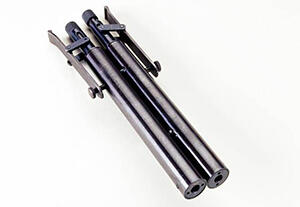 Poison gun with two barrels
Poison gun with two barrels
HURI: So, speaking of the poison gun itself... is that something that was commonly used? Was Stashinsky the only one to use it? Did the KGB continue using it, do you know?
SP: What we know is that in the 1950s they were trying to use these technological achievements to improve the art of the killing. The crimes became more and more innovative. And one of the things that they were already trying to use was radioactive polonium back in the 1950s. We know about the failed attempt to kill one of the defectors with polonium, and we know about the Stashinsky gun.
In both cases, we know about them because something went wrong. There probably were more cases like that, there were quite a few suspicious deaths, including among the leaders of the Ukrainian immigration, but these are the two cases that we know about: One dealing with the Russian defector, one with the leaders of the Ukrainian immigration.
My understanding is that the original gun was an improved version of a gun used by the German intelligence during the Second World War. I'm not an expert on those gadgets, so I can't say that with 100% certainty, but looking at different types of this spray gun or poison gun (including at the Spy Museum here in Washington DC), that's the connection I made. And they kept improving it, because Rebet was killed with a gun that had just one barrel. By the time they got to killing Bandera, the gun had two barrels, and Stashinsky pushed the trigger for both barrels at the same time. That was one of the reasons it became clear that it was an assassination or poisoning, not a heart attack.
HURI: Because the dose was higher?
SP: Yes, they were able to detect traces of cyanide in Bandera’s lungs.
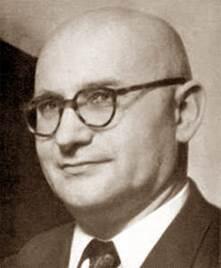 Lev Rebet
Lev Rebet
HURI: Bandera was not the first émigré leader killed by Stashinsky. Can you tell us more about Lev Rebet and why the KGB decided to kill him?
SP: The first person Stashinsky killed in 1957 was indeed Lev Rebet, in Munich. He was one of the leaders of the branch of the Ukrainian nationalist organization that was in conflict with Bandera and his people. He was more of an intellectual leader than an organizer; he was the editor of a newspaper in Munich. He didn't have any protection, lived an open life, and used his real name - unlike Bandera, who had documents made in the name of Stefan Popel and his whereabouts, where he worked, and where he lived were a matter of secrecy. That wasn't the case with Lev Rebet, so it was easier to get to him.
The plan was that by killing Rebet, the suspicion would fall on Bandera and on other groups within the émigré community, and that would create conflict. What probably surprised the KGB about the success of that attempt was that in the end it was impossible to figure out it was an assassination, as opposed to dying from natural causes. Heart attack was the diagnosis.
Once the KGB discovered they were so effective, the next target was Stepan Bandera himself, who was the leader of the largest, best-organized Ukrainian nationalist organization in the West.
HURI: You were able to put to rest some of the speculations or theories surrounding the assassination. Can you talk a little about what those were?
SP: There are some conspiracy theories that could never be put to rest. For example, some people are saying that Harvey Lee Oswald was trained in the same KGB facility as Stashinsky, which is absolute nonsense, but there are conspiracy theories like that. There always will be "alternative facts." So I'm leaving those things aside.
But one of theories that got enough traction and was considered to be legitimate was this: A few years ago in Kyiv, an interview was published, allegedly with Stashinsky, who lived in Kyiv, and who told a reporter that, in addition to carrying out the murders on KGB orders, he defected on the orders of the KGB, to show how powerful the KGB was. That theory, and I show this in the book, doesn't hold water at all. It just goes against everything we know from the CIA archives, in terms of CIA involvement, which was very limited. The CIA didn't trust Stashinsky back in 1961. They dumped him on the Western Germans. They didn't trust him in 1976, so that part certainly doesn't support other theories about the CIA. With regard to the article that was published in Kyiv, we know that Stashinsky’s defection caused a major scandal within the KGB, within the security services, but also within the highest level of the Politburo. The person who was in charge of this operation and eventually awarded Stashinsky a high Soviet award, would become one of the political casualties of Stashinsky’s revelations.
His name was Aleksandr Shelepin, and he was the rival of Leonid Brezhnev in the 1960s and 1970s, and most of the observers in the ‘60s thought that Brezhnev was a transitional figure, that the real power in the Politburo was Shelepin. It was this particular case and the publicity that it acquired after Stashinsky’s defection, after the trial, that made first Shelepin a persona non grata abroad, and was used by Brezhnev and his other rivals to remove him from the Politburo.
From that point of view, Stashinsky defecting and trying to show what a powerful figure Shelepin was and how powerful the KGB was, of course, doesn't make much sense.
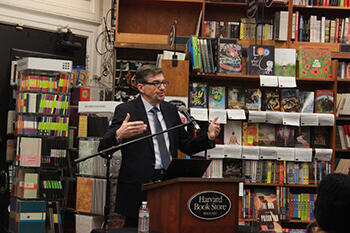 Serhii Plokhy at Harvard Book Store
Serhii Plokhy at Harvard Book Store
HURI: Changing course a little bit, I know you've had many talks, reviews, and presentations about this book. Have you had any responses or questions that surprised you?
SP: It's not surprising, but it's certainly interesting that in different countries, this story becomes interesting for different reasons. If you look at the reviews that appeared in the UK, for example, most of the titles have "James Bond" in them (there is some connection between the book at the James Bond story, particularly the last James Bond novel, where he uses the Stashinsky gun to attempt to assassinate his boss).
The book didn't appear in Ukraine, in Ukrainian, or in Russia, in Russian, but I was interviewed by Radio Liberty and the Ukrainian radio service, Hromadske radio, among others. In Ukraine, it's not James Bond, it's the figure of Stepan Bandera that is most important. Again, there are debates and discussions; he's a very controversial figure in today's Ukraine, especially in the context of the de-communization laws. So there it's not James Bond, but Bandera who attracts most attention.
Here in the United States, it's the context of the allegations that Russia and Russian intelligence services interfered with the American election that serves as a background for interest in the book.
In terms of any specific questions, everyone across the board, no matter what country, is interested in whether Stashinsky is still alive, and whether I am going to track him down.
HURI: And are you?
SP: I don't think so. After all, I am a historian, and unless those materials are in the archives, the chances are very low that I would travel somewhere and get involved in that kind of investigation.
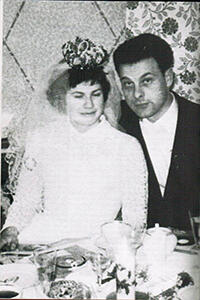 Bohdan Stashinsky and Inge Pohl on their wedding day
Bohdan Stashinsky and Inge Pohl on their wedding day
HURI: Was there anything in your research that was surprising to you? It could be peripheral to the book, even.
SP: The first surprise was at the very beginning, which was the trigger for me to write the book, and that's that the CIA really was so skeptical about Stashinsky from the very beginning, about his testimony at the court, and that it took such a long period of time for them to figure out whether he was telling the truth or not.
Other than that, it was really interesting to dive into the period of the 1950s and early 1960s and look at worlds that were brought together by the same story but were very separate worlds. This was the Soviet Union and the United States/West Germany, at that moment in time. It's the same story, but the actors that come together come from different backgrounds, and their views on the world around them was very different.
In that context, very interesting is the story of Inge Pohl, the wife of Stashinsky. She was one of the key figures in this escape saga, and her impressions of Moscow life in the 1960s became a major motivating factor in Stashinsky’s escape. She was coming from Berlin. She didn't want to go to Moscow, she hated everything she saw around, and this comparison between life in Berlin - destroyed by the war - and Moscow, the capital of the victorious power was not in favor of the Soviets. She was appalled by how the apartment buildings looked, where the garbage was, how people were dressed, and things like that. That was very interesting. As in many other cases and projects, your research is a time machine, where you’re putting yourself into the context that the participants in the story lived and penetrate the different worlds in which they belonged. That's maybe the most interesting and rewarding part of this kind of research.
HURI: I know you have a few other projects in the works. Is there any other topic in the back of your mind that you haven't started yet?
SP: There are a few, but I will talk about the one that is next in the pipeline. This book is very different. It's not looking at any one particular episode or life, and it has nothing to do with the intelligence services.
The book is about the formation of Russian identity, as it is related to Ukrainian and Belarusian. Over the last few years, we heard a lot about Vladimir Putin saying that Russians and Ukrainians are one and the same people. This book is an attempt to understand where this thinking is coming from. Again, it reflects not just the thinking of the president of Russia; the polls are saying that the majority of Russians are of the same opinion.
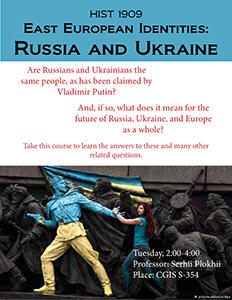 The title of the book will be "Lost Kingdom." Lost Kingdom refers on the one hand to Russia’s preoccupation with bringing back the unity of Kyivan Rus', the lost kingdom of Medieval times, but also Russia is, in a sense, becoming a “lost kingdom” or losing its way in pursuing this idea, this very Medieval idea, in the age of modern nation building. It’s a book that will cover more than 500 years of history, so a very different one in terms of the chronological scope and the questions that I ask.
The title of the book will be "Lost Kingdom." Lost Kingdom refers on the one hand to Russia’s preoccupation with bringing back the unity of Kyivan Rus', the lost kingdom of Medieval times, but also Russia is, in a sense, becoming a “lost kingdom” or losing its way in pursuing this idea, this very Medieval idea, in the age of modern nation building. It’s a book that will cover more than 500 years of history, so a very different one in terms of the chronological scope and the questions that I ask.
HURI: Is it related to the course you're teaching?
SP: It is related to the course I'm teaching this semester. The course is "East European Identities: Russia and Ukraine," and it covers the 19th and 20th centuries. The book starts with the times of Ivan the Third, so it goes much further back.
HURI: So your students will get a teaser, and then they'll have to go buy the book.
SP: I guess so!